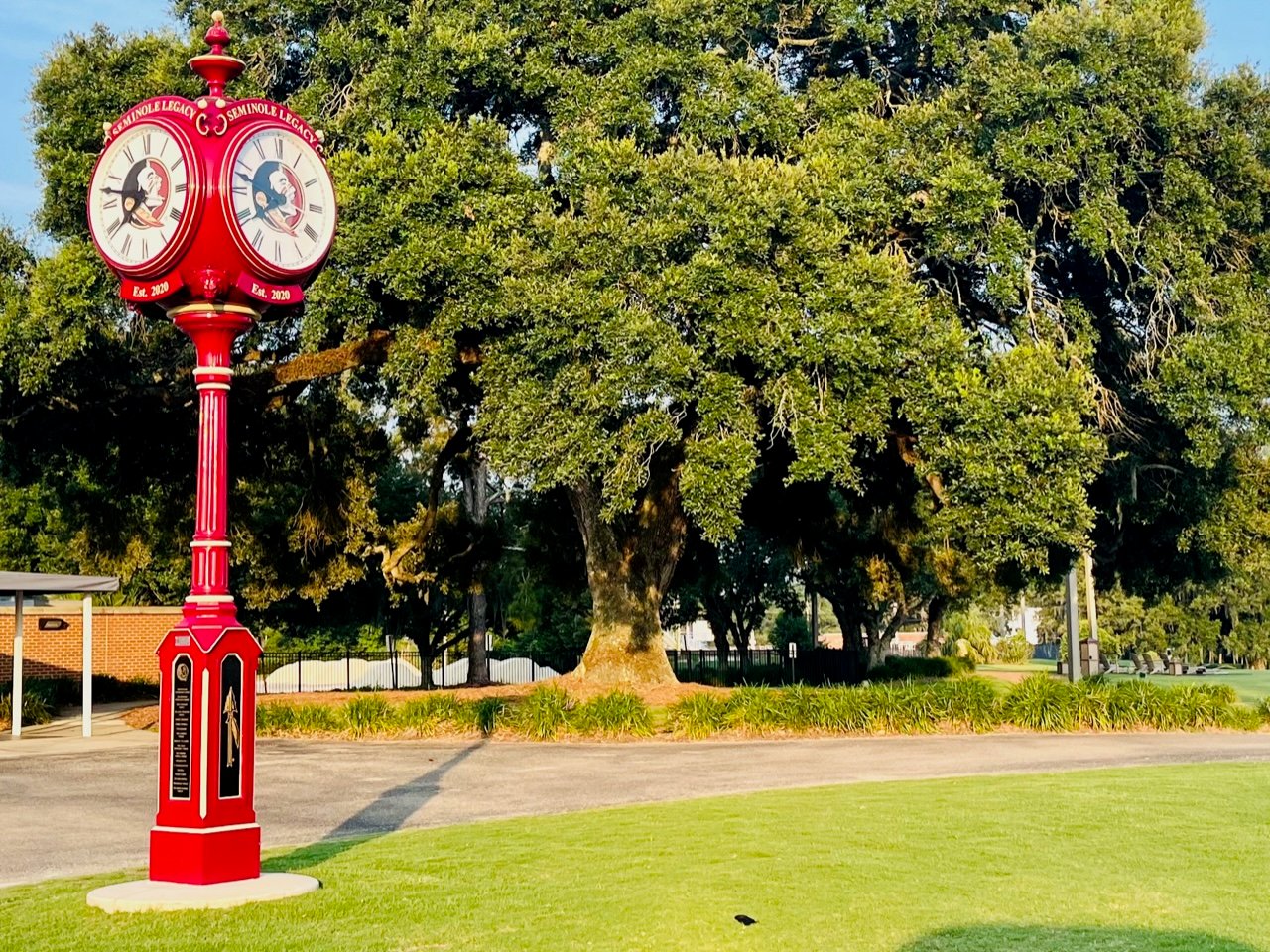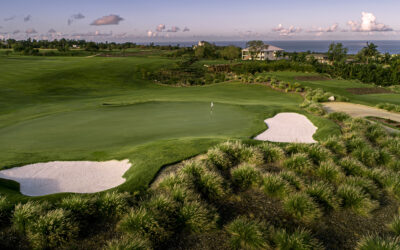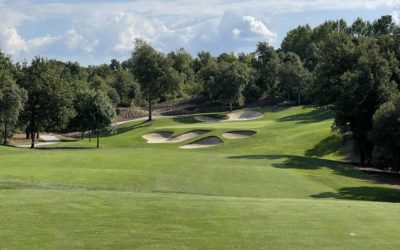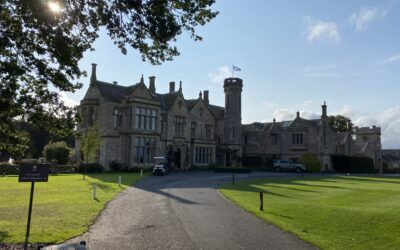No matter how many times you’ve seen it on television, admired photos of it, read about it in magazines or heard others describe it, nothing quite prepares you for the real thing. And there it was right in front of me, beneath my feet and all around me ….pine straw. Just as distinctively Augusta as the azaleas, rhododendrons and dogwood trees, it was a thrill to touch it, feel it and nick a couple of bits for souvenirs.
As for the course, well it’s fifty times more beautiful than you can imagine and a hell of a lot hillier than it looks on television. An exotic hybrid – part Kew Gardens, part Capability Brown style landscape – it’s extraordinarily pretty. Because there’s no rough worthy of the name, only the clumps of towering pines, sparkling water features, fabulous flowers and dazzling white bunkers interrupt the verdant lusciousness of the rolling fairways and super-smooth greens. It’s really just a perfect and massive lawn split into 18 separate sections by strategic features.
There’s no point in looking for dandelions, daisies or buttercups as it’s a totally weed-free zone. Timed to reach their floral peak as the leaders step onto the first tee on Sunday afternoon, the flowers are as obedient as the spectators, or patrons as they are called. The place is almost eerily immaculate and is kept that way by a huge army of gardeners, greenkeepers, litter collectors and sundry other personnel.
Walking around the course is as easy on the feet as it pleasing on the eye, thanks to the lush grass and, yes, the wonderfully soft pine straw. Because we see less of them on the TV coverage, the holes on the front nine are rather less familiar. Each is named after a plant and Juniper, the par three 6th, is my favorite. Plucky spectators sit out of sight beneath the elevated tee and watch the balls thump into a green that has more tricky slopes than an Alpine ski resort.
As with almost every other green at Augusta, you learn to suppress your instinctive enthusiasm and not clap or cheer when a ball lands close to the pin. Premature applause can be extremely embarrassing. Instead, you wait patiently until it stops rolling 5, 10, 15 or 20 seconds later because only retrospective assessments are safe in this treacherous context.
The back nine begins with a dramatic descent. Both 10 and 11 plunge downhill and whisk you from the highest to the lowest point on the course and into Amen Corner. As someone who tops the ball fairly consistently off the tee, these two holes worry me rather less than it would appear they do the pros. However, the pond just to the left of the 11th green is another matter.
Surveying the frighteningly narrow tee-shot on the 18th tee, I wondered how many shots I would need to be leading by come Sunday afternoon to feel confident about slipping on a green jacket after the round. Seven or eight might just be enough. I thought I felt my ears pop as I climbed steeply uphill to the final green.
On the summit sits the extremely elegant, white, 150-year-old, colonial-style clubhouse with its distinctive cupola. One side overlooks the course while the other gazes down the 300-yard long, straight and tree-lined Magnolia Lane, the normal entrance to Augusta National. During the Masters, however, everyone other than VIPs has to use what appears to be the tradesmen’s entrance around the side. It’s not only perfectly adequate for the task but also delivers a rather subtle message about the relative status of those who live here, as it were, and those who are just visiting for the week.
To be honest, the place is a touch intimidating even for a fearless and mature investigative journalist. Lurid tales of people being ejected for various seemingly minor misdemeanours such as running, contribute to a mild but unmistakeable climate of fear. Apparently, one famous BBC radio presenter was initially banned for life for inadvertently leaving the press centre with a mobile phone in his pocket. Even the fact that it was switched off didn’t mitigate the crime in the eyes of the authorities.
Augusta National is a bit like a smart and rather strict public school where the green jacketed members are the prefects. One of them turned Ricky Fowler’s peaked cap back round the right way at his press conference. He protested mildly and was lucky to escape a detention, as was a journalist friend of mine who attempted to smuggle a popsicle onto the course. He was admonished and it was summarily confiscated. Following him out, I half expected to hear, “And you can wipe that smile of your face, Agran. And for goodness sake take your hands out of your pockets, boy, and tuck your shirt in.”
Looking for a suitable spot to have a few photos taken, I naively offered to carry one of the two cameras the photographer was lugging around. Instead of thanking me, he told me off. “You’re not an accredited cameraman. Do you want to get us both thrown out?” It’s like that; just a tiny bit frightening.
You could try and argue that these were needless and petty interferences that conflicted with the basic human right to wear caps back to front, suck popcicles in the sunshine, have your shirt un-tucked, keep your hands in your pockets and carry whoever’s camera you want but you would be wasting your time as no one would listen. And there’s no appetite around these parts for revolution. The regime may be unashamedly undemocratic and undeniably autocratic but it’s also undoubtedly benign, popular and supremely successful.
One of the more understandable rules is that you mustn’t bring a firearm onto the course even if, as the sign says, you have a licence for it. Smoking is prohibited in certain areas, mobile phones, cameras and electronic devices are not allowed and there’s a ‘no autograph policy’. Other banned objects you can’t bring onto the premises include alcoholic beverages, flags, banners, signs, backpacks, ladders, periscopes, radios, tape recorders and strollers. Laid out end to end, the prohibited items would comfortably stretch the length of Magnolia Lane.
Although the rules are firmly enforced, the enforcers are incredibly courteous in that friendly Southern way. They smiled readily, disarmingly kept calling me ‘sir’ and were forever urging everyone to ‘have a nice day’, but you had better do what they say. Despite the lingering dangers, the atmosphere is incredibly cordial and the patrons willingly enter into the spirit of the occasion by behaving more or less impeccably.
The Masters is a wonderfully classy tournament and the Augusta National Golf Club is determined to ensure that the highest standards are maintained. Even though some of the rules seem a touch petty and are rather vigorously enforced, you can’t really blame the green jackets for wanting to keep everything as perfect as possible.
Nowhere is this obsessive striving for perfection more evident than with the course itself. So dense and even is the grass on the fairways that it looks and feels like the finest Axminster carpet. The putting surfaces are, of course, flawless and the overall visual impact is both stunning and overwhelmingly green. Where heavy pedestrian traffic causes a slight browning of the surface, a green gravelly substance is regularly sprayed about to restore the verdant look. Everything is green from the litter sacks to the chairs fans use to reserve favoured spots around the tees and greens.
These chairs, together with a panoramic range of logoed merchandise, can be bought at various outlets concealed around the estate. Together they generate tens of millions of dollars for the club. As far as I was able to tell, the gear is tasteful, of good quality and not unreasonably priced. The only thing not on sale that I would have quite liked to own is a green jacket itself. Mind you, I dread to think what appalling fate awaits a man found guilty of masquerading as an Augusta member.
The queues to buy stuff were of par five proportions as those who had made it to the Masters purchased evidence to confirm their achievement. But for absolutely incontrovertible proof that you were there in the flesh, there was a more modest queue to have your photo taken next to the famous flowerbed in front of the even more famous clubhouse.
Although undoubtedly envious of the members, I nevertheless wonder why anyone would want to join a club where the course is given over to visiting professionals for a week every spring and is closed throughout the summer. Okay, it’s one of the finest inland courses in the world which everyone who has ever gripped a club dreams of playing and there is almost as much prestige attached to being a member of Augusta National as there is to actually winning a major, but it’s hardly cheap and you’re restricted as to how often you can play.
Having observed what goes on during the tournament, I have developed a sort of theory. Far from being a pain in the backside when you can’t tee it up on your own course, the Masters is the green jacketed members’ literal and metaphorical week in the sun. This is their golden chance to rub shoulders with past legends and current heroes. They were all there – Arnie, Jack, Gary and pretty well every living former Masters champion. A few played, most didn’t. As well as attending the formal dinners and receptions, they knock around the clubhouse and happily chat to the green jackets and others.
Although today’s best players were rather more preoccupied and consequently considerably less sociable, nevertheless there were opportunities for the green jackets to meet them. For example, the big names and those atop the leaderboard are obliged to give press conferences. They are accompanied at these by a green jacket drawn from a roster of media committee members, who introduces them, invites questions from the journalists and runs the press conference. There’s absolutely nothing wrong with this and they conduct the proceedings exceedingly well but what a thrill it must be for them to subsequently reveal to their mates at the plantation, distillery or pine straw processing plant, “What a dee-lightful ‘n’ fiiine yerng maaaaan is that Roooooreee McIlroooooy”.
The Masters is also a glorious social event not unlike Badminton where the green jackets can entertain their families, friends and associates. They breakfast on the clubhouse balcony, dine in the excellent restaurant and sip cocktails on the immaculate front lawn. All of which are elegant pleasures that I enjoyed thanks to Augusta’s extremely hospitable policy of allowing visiting journalists access to the quaint and cosy clubhouse. Perhaps they do so as compensation for not letting us inside the ropes. Understandably, they don’t want scruffy journalists and dishevelled photographers cluttering up the fairways and diminishing the course’s aesthetic appeal.
Augusta is simply breathtakingly beautiful, nowhere more so than around Amen Corner. Sitting upright on the bank (having been admonished for briefly tilting back to rest on my elbows) just to the right of the 12th tee, I spent a sublime Saturday afternoon soaking up that wonderfully familiar view and communing with the golfing gods. I imagined them huddled together in golf heaven drinking fine scotch on the rocks – in their green jackets.

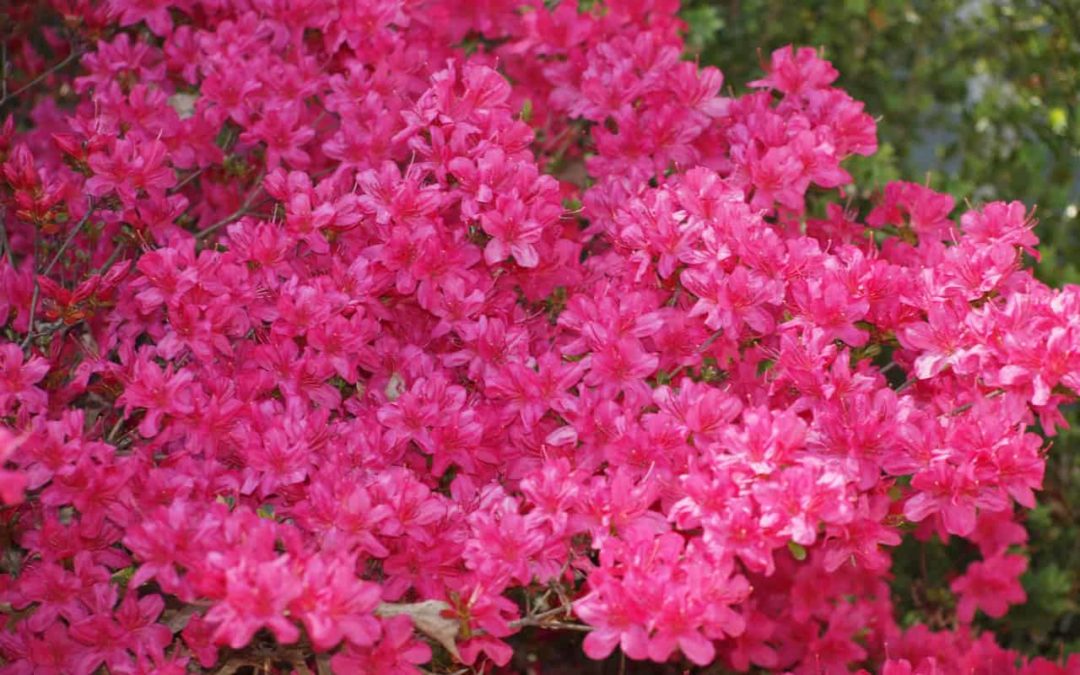

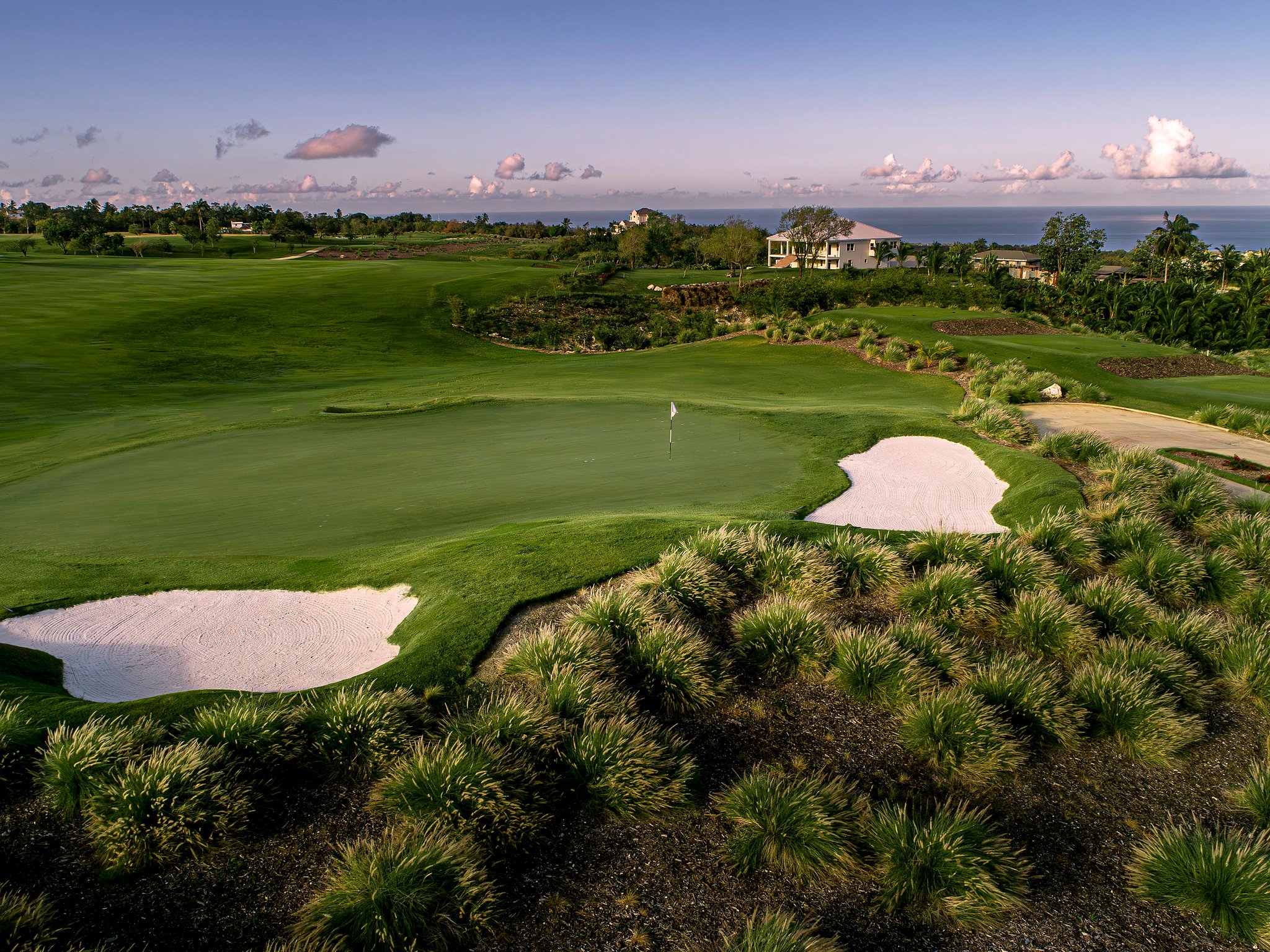
 0
0
